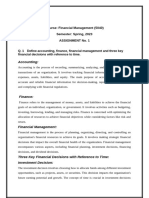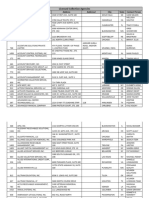0 ratings0% found this document useful (0 votes)
21 viewsThank You Scribd
The document provides an introduction to the field of finance. It defines finance as the study of fund management and asset allocation over time. The two main drivers of finance are the time value of money and risk. Finance seeks to ensure assets change value in a beneficial way for individuals and organizations. The role of corporate finance is to maximize shareholder value by optimally allocating assets and managing liabilities.
Uploaded by
Jazzmin Rae BarbaCopyright
© © All Rights Reserved
Available Formats
Download as PDF, TXT or read online on Scribd
0 ratings0% found this document useful (0 votes)
21 viewsThank You Scribd
The document provides an introduction to the field of finance. It defines finance as the study of fund management and asset allocation over time. The two main drivers of finance are the time value of money and risk. Finance seeks to ensure assets change value in a beneficial way for individuals and organizations. The role of corporate finance is to maximize shareholder value by optimally allocating assets and managing liabilities.
Uploaded by
Jazzmin Rae BarbaCopyright
© © All Rights Reserved
Available Formats
Download as PDF, TXT or read online on Scribd
You are on page 1/ 1
Boundless Finance
Introduction to the Field and Goals of Financial
Management
Introducing Finance
Defining Finance
Finance is the study of fund management and
asset allocation over time.
LEARNING OBJECTIVES
Explain the importance of time to the
discipline of finance
KEY TAKEAWAYS
Key Points
The two main drivers of finance are
the time value of money and risk.
Since the value of assets changes
over time, finance seeks to ensure
the change is beneficial for the
organization or individual.
Financial professionals generally
operate in an environment of
uncertainty where they must make
forecasts about future events.
Key Terms
investment: A placement of capital
in expectation of deriving income
or profit from its use.
asset: Something or someone of
any value; any portion of one’s
property or effects so considered.
debtor: A person or firm that owes
money, one in debt, or one who
owes a debt.
Overview
Finance is the study of fund management and
asset allocation over time. Funds consist of money
and other assets. There are many different types of
finance, but all are fundamentally concerned with
studying how best to allocate assets in different
conditions over time.
Importance of Time
The underlying driver behind all of finance is time.
There are two reasons why time is so important to
finance:
1. Time value of money: For a number of
reasons, money today is worth more than the
same amount of money in the future. For
example, you would rather have $100 today
than $100 in 10 years – the money is worth
more to you now than it would be in the
distant future. We will explore this concept in
greater depth later on.
2. Risk: Making an investment does not
guarantee a return. When a bank makes a
loan, they’re not sure the debtor will pay it
back. There is a risk that the person will just
take the money and run, the debtor will file
for bankruptcy, or, for dozens of other
reasons, the bank will not get the money
they lent back.
The field of finance, however, embraces time.
Finance says, “Since I know assets change value
over time, how do I use that to cause my assets to
change value in the direction I want? How do I
manage assets so that they’re worth more in the
future than they are today? ”
Challenges in Finance
Figuring out what to do with assets is sometimes
easy: all of the variables are known, and there is
clearly an option that is better than all the others.
However, most of the time, this is not the case.
Finance generally operates with a lot of
uncertainty. As a result, companies hire entire
departments of people to help them figure out
which option is best.
Walmart CFO: Charles Holley, the Chief Financial Officer
(CFO) of Wal-Mart, is in charge of making sure all of Wal-
Mart’s assets are allocated as optimally as possible.
Comparing the Fields of Finance,
Economics, and Accounting
Finance, economics, and accounting are business
subjects with many similarities and differences;
each is a distinct field of study.
LEARNING OBJECTIVES
Recognize how finance, economics and
accounting overlap.
KEY TAKEAWAYS
Key Points
Finance is the study of how to
optimally allocate assets. Finance is
fundamentally a forward looking
field, concerned with what an asset
will be worth in the future.
Economics is the social science
that analyzes the production,
distribution, and consumption of
goods and services.
Accounting is the process of
communicating financial
information about a business.
Accounting is fundamentally a
backward-looking field.
Key Terms
return: Gain or loss from an
investment.
Finance, economics, and accounting are business
subjects with many similarities and differences.
While they influence each other, each is a distinct
field of study.
Finance
Finance is the study of how to optimally allocate
assets—how individuals and organizations should
invest assets in order to get the highest possible
return given changing conditions over time.
Finance is fundamentally a forward looking field,
concerned with what an asset will be worth in the
future.
Economics
Economics is a social science that analyzes the
production, distribution, and consumption of goods
and services. It focuses on how economic agents
(people, businesses, and government) interact and
make decisions. Economics is fundamentally the
study of cause and effect. It tries to figure out how
one variable affects economic agents or the
economy as a whole.
Accounting
Accounting focuses on communicating a
businesses’ financial information. Accounting is
fundamentally a backward-looking field, concerned
with what has already happened financially and
what position that leaves the company in today.
If accounting is called the language of business,
then the financial statements that accountants
prepare are the words. Statements are created
under a standardized set of accounting laws, which
allows one to easily compare and contrast
companies. This indicates how financially healthy a
company is.
Balance Sheet: The balance sheet is one of the three main
financial statements. The other two are the cash flow
statement and the income statement.
Overlap
Finance, economics, and accounting overlap in a
lot of areas. For example, an investor will use
accounting to see whether a company has shown
past financial success and to predict what the
company will look like in the future. Part of that
prediction incorporates economics. The investor
wants to know what the overall economy will look
like in the future and wants to know how the
company will interact with its competitors. The
investor can use finance to figure out what his or
her investment will be worth in the future.
There are few strong delineators between finance,
economics and accounting. All three fields
intermingle and influence one another. It is almost
impossible to have a strong grasp of one without
at least a basic understanding of the other two.
Role of Finance in an Organization
The primary role of corporate finance is to
determine how best to maximize shareholder
value.
LEARNING OBJECTIVES
Define the role of finance in an
organization
KEY TAKEAWAYS
Key Points
Maximizing shareholder value can
be done over the long-term or the
short-term, so the job of the finance
department is to determine how
best to do both. Sometimes, the
goals may appear to contradict
each other.
The finance department is devoted
to the task of figuring out how to
allocate assets for the overarching
goal of maximizing shareholder
value. They must ensure that the
right assets are in the right place at
the right time.
The finance department must also
manage the company’s liabilities so
that all projects are financed in an
optimal way without taking on too
much risk.
Key Terms
shareholder: One who owns shares
of stock.
asset: Something or someone of
any value; any portion of one’s
property or effects so considered.
liability: An obligation, debt or
responsibility owed to someone.
Corporate finance is the area of finance dealing
with monetary decisions that business enterprises
make. When finance is talked about in the context
of business decisions, it is called corporate finance
(technically, corporate finance deals only with
corporations, while managerial finance deals with
all types of companies, but we will use the terms
interchangeably). There are other branches of
finance such as personal finance (individuals taking
care of their money) and public finance (the
finances of the government).
The primary goal of corporate finance is to
maximize shareholder value. Maximizing
shareholder value can be done over the long-term
or the short-term, so the job of the finance
department is to determine how best to do both.
Sometimes, the goals may appear to be in
competition with one another. For example, a
company can choose to pay dividends (a small
payment to each person who owns a stock of a
company), which increases short-term shareholder
wealth. However, paying dividends means that the
money is not being invested in long-term
investments, which may cause the stock price to
increase more in the future, and thereby increasing
long-term shareholder wealth.
The technique behind maximizing shareholder
value is the management of assets. This means
that the finance department figures out how to
best invest its money.
For example, a company could have two proposals
from the R&D department to develop different
products, but only enough money to fund one. The
finance department will project out the future
revenues and costs of each product and figure out
which one, if either, is worth the money.
iPod Touch: Apple used financial analysis to decide to fund
the development of the iPod. The money allocated
development could not be used for another project, but the
finance department determined the iPod was the best
option.
Also, the finance department will determine when
a company should take on a liability. For example,
suppose both projects are absolute home-runs, but
the company still only has enough money to fund
one. The finance department will figure out if the
company should borrow money so that it can fund
both.
The role of finance in an organization is to make
sure that money is at the right place at the right
time. A company wants to have enough money to
pay its bills, but also wants to invest so that it can
grow in the future. The finance department is
devoted to the task of figuring out how to allocate
assets to do so, for the overarching goal of
maximizing shareholder value.
Types of Financial Decisions: Investment
and Financing
Investment and financing decisions boil down to
how to spend money and how to borrow money.
LEARNING OBJECTIVES
Identify the criteria a corporation must use
when making a financial decision
KEY TAKEAWAYS
Key Points
The primary goal of both
investment and financing decisions
is to maximize shareholder value.
Investment decisions revolve
around how to best allocate capital
to maximize their value.
Financing decisions revolve around
how to pay for investments and
expenses. Companies can use
existing capital, borrow, or sell
equity.
Key Terms
expected return: Considering the
magnitude and likelihood of
exogenous events, the yield that an
investor predicts s/he will earn on
average.
financing: A transaction that
provides funds for a business.
equity: Ownership, especially in
terms of net monetary value, of a
business.
There are two fundamental types of financial
decisions that the finance team needs to make in a
business: investment and financing. The two
decisions boil down to how to spend money and
how to borrow money. Recall that the overall goal
of financial decisions is to maximize shareholder
value, so every decision must be put in that
context.
Investment
An investment decision revolves around spending
capital on assets that will yield the highest return
for the company over a desired time period. In
other words, the decision is about what to buy so
that the company will gain the most value.
To do so, the company needs to find a balance
between its short-term and long-term goals. In the
very short-term, a company needs money to pay its
bills, but keeping all of its cash means that it isn’t
investing in things that will help it grow in the
future. On the other end of the spectrum is a
purely long-term view. A company that invests all
of its money will maximize its long-term growth
prospects, but if it doesn’t hold enough cash, it
can’t pay its bills and will go out of business soon.
Companies thus need to find the right mix
between long-term and short-term investment.
The investment decision also concerns what
specific investments to make. Since there is no
guarantee of a return for most investments, the
finance department must determine an expected
return . This return is not guaranteed, but is the
average return on an investment if it were to be
made many times.
The investments must meet three main criteria:
1. It must maximize the value of the firm, after
considering the amount of risk the company
is comfortable with (risk aversion).
2. It must be financed appropriately (we will talk
more about this shortly).
3. If there is no investment opportunity that fills
(1) and (2), the cash must be returned to
shareholder in order to maximize
shareholder value.
Financing
All functions of a company need to be paid for one
way or another. It is up to the finance department
to figure out how to pay for them through the
process of financing.
There are two ways to finance an investment:
using a company’s own money or by raising money
from external funders. Each has its advantages and
disadvantages.
There are two ways to raise money from external
funders: by taking on debt or selling equity. Taking
on debt is the same as taking on a loan. The loan
has to be paid back with interest, which is the cost
of borrowing. Selling equity is essentially selling
part of your company. When a company goes
public, for example, they decide to sell their
company to the public instead of to private
investors. Going public entails selling stocks which
represent owning a small part of the company. The
company is selling itself to the public in return for
money.
NYSE: If a company chooses to finance an investment by
selling equity, they may issue stocks on an exchange like
the New York Stock Exchange
Every investment can be financed through
company money or from external funders. It is the
financing decision process that determines the
optimal way to finance the investment.
Functions of Corporate Finance
Corporate finance utilizes tools and analysis to
make sound financial business decisions.
LEARNING OBJECTIVES
Describe the role of finance in corporation
KEY TAKEAWAYS
Key Points
The finance group is in charge of
budgeting. It will look for the
optimal allocation of assets across
all business functions.
Corporate finance decides how
best to finance projects. The
department can either use existing
internal funds, borrow money, or
sell equity.
The finance group must balance
both short- and long-term company
goals, though the overarching goal
is to maximize shareholder value.
Key Terms
finance: To provide or obtain
funding for a transaction or
undertaking; to back; to support.
investment: A placement of capital
in expectation of deriving income
or profit from its use.
Corporate finance deals with monetary decisions
that business enterprises make and the tools and
analysis utilized to make the decisions. Corporate
finance is concerned primarily with making
investment and financing decisions; that is, making
sure that money is being used in the best way.
The corporate finance department of a company is
in charge of budgeting. Management must allocate
limited resources between competing
opportunities; since a dollar cannot be used for
more than one project at once, it is a challenge to
determine how much money should be allocated
to each part of the business.
You might also like
- Introduction To Managerial Finance: 1) Essay Questions100% (1)Introduction To Managerial Finance: 1) Essay Questions22 pages
- Finanical managment bba 4TH SEM PYQ ACCORDING ANSWERS -1No ratings yetFinanical managment bba 4TH SEM PYQ ACCORDING ANSWERS -141 pages
- Finance, ITS DEFINITION, IMPORTANCE AND FUNCTIONNo ratings yetFinance, ITS DEFINITION, IMPORTANCE AND FUNCTION20 pages
- Finance Is The Lifeline of Any BusinessNo ratings yetFinance Is The Lifeline of Any Business22 pages
- Need of Knowing Finance - A Managerial Perspective: Unit - 1 FINANCIAL MANAGEMENT (Corporate Finance)No ratings yetNeed of Knowing Finance - A Managerial Perspective: Unit - 1 FINANCIAL MANAGEMENT (Corporate Finance)24 pages
- Introduction to Finance Lecture 1 Baf 101No ratings yetIntroduction to Finance Lecture 1 Baf 10163 pages
- Asian University of Bangladesh: Assignment OnNo ratings yetAsian University of Bangladesh: Assignment On17 pages
- Business Finance Lessons, 2,3,7,8,9, and 10No ratings yetBusiness Finance Lessons, 2,3,7,8,9, and 1062 pages
- Introduction To Corporate Finance: Syed M. Abdur Rehman ShahNo ratings yetIntroduction To Corporate Finance: Syed M. Abdur Rehman Shah27 pages
- Principle of Finance: MBA-607 Dr. Saleh Md. Mashedul IslamNo ratings yetPrinciple of Finance: MBA-607 Dr. Saleh Md. Mashedul Islam17 pages
- Chapter 1: Overview: Classification of FinanceNo ratings yetChapter 1: Overview: Classification of Finance8 pages
- Chapter 1: Overview: Classification of FinanceNo ratings yetChapter 1: Overview: Classification of Finance8 pages
- Expert Financial Analysis: Strategies for Professional SuccessFrom EverandExpert Financial Analysis: Strategies for Professional SuccessNo ratings yet
- Economic, Business and Artificial Intelligence Common Knowledge Terms And DefinitionsFrom EverandEconomic, Business and Artificial Intelligence Common Knowledge Terms And DefinitionsNo ratings yet
- Ipomoea Aquatica: Jump To Navigation Jump To SearchNo ratings yetIpomoea Aquatica: Jump To Navigation Jump To Search11 pages
- Financial Statements: Join PRO or PRO Plus and Get Lifetime Access To Our Premium MaterialsNo ratings yetFinancial Statements: Join PRO or PRO Plus and Get Lifetime Access To Our Premium Materials1 page
- Statistics Is The Science Concerned With Developing and Studying Methods For Collecting, Analyzing, Interpreting and Presenting Empirical DataNo ratings yetStatistics Is The Science Concerned With Developing and Studying Methods For Collecting, Analyzing, Interpreting and Presenting Empirical Data4 pages
- Synopsis - India'S Equalisation Levy 2020: Issues, Perspectives and Tax PositionsNo ratings yetSynopsis - India'S Equalisation Levy 2020: Issues, Perspectives and Tax Positions2 pages
- ATTY. ROGELIO S. CONSTANTINO v. ATTY. NEMESIO A. ARANSAZO, JR.No ratings yetATTY. ROGELIO S. CONSTANTINO v. ATTY. NEMESIO A. ARANSAZO, JR.1 page
- Search in Book : Chapter 5 - Stocks and Stock ValuationNo ratings yetSearch in Book : Chapter 5 - Stocks and Stock Valuation20 pages






































































































